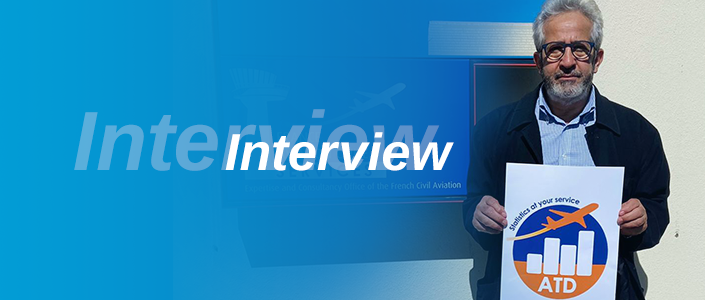M.Merhdad FARZIN POUR’s interview
He is an air transport specialist, and more especially in the evolution and data analysis field for several years. During his long career, he decided to create the Air Transportation Data (ATD) database that concentrates global results in commercial air traffic.
Would you like to tell us the Air Transport Data (ATD)’s story, please?
All begins in 1995, I was working at the Institute of Air Transport (ITA) at Paris. In October 1986, a mission that consists of creating a “computing database” from “paper” (or hand-writing) data about aerial Transport had been confided to me. This work aims to modernize those data support in order to make it accessible to the public.
In 1986, The Directorate-General for Civil Aviation (DGAC) asked ITA to enrich that database with additional information dealing with the airline (fleet configuration, air traffic, financial data). This is precisely the request that ATD gets into…
From this moment, a portfolio of contact has been developed towards different aerial sector actors starting recovery data. Those exchanges enable us to identify genuine interest in developing this database while including new data as airports, flows between cities… That is how the following basis: “Airports”-“Airlines”- “traffic streams” were born.
Would you describe the main steps of this project’s development, please?
The ATD could be summed up in 3 main periods:
- Until 2006: For 20 years, it consists of making strengthening work and data development under the aegis of ITA.
During this period, ATD’s commercialization started! Likewise, It consists of pursuing new information sources research throughout the world. The purpose is to be able to answer the customer’s needs.
- In 2006, ITA stop their activities and the French civil aviation university (ENAC) took ATD over.
For 13 years, on top of regular customers, new buyers come to light: Students, Enac researchers, the staff of DGAC…
- 2019: the GIE “France aviation civil services” (FRACS) bought ATD back. Since that day, consolidation work and data enrichment have always been in progress.
What are your motivations to keep working on ATF project for more than 30 years?
To make a success in that kind of project, and be efficient enough, it has to devote time to the latter. During these 30 years, plenty of events occurred in the world and had had an impact on aerial transport: 11th of September 2001- Eyjafjallajökull volcano in 2010- Coronas virus (COVID 20)… Each situation was different. It had been pretty interesting to be able to observe how each sector manages to overcome and follow their roads up.
Analyze tendencies, develop databases, increase portfolio of contacts, sell this work… These moments of well-lived have always been a great pleasure for me, and honestly, time is passing so quickly that we are not even aware.
Working on a “living” (or “alive”) material, evolving and which is regularly freshened, is really motivating.
Which information are we able to find in your database?
In actual fact, there are 3 different databases that each gather some thousands of annual information about:
- Traffic streams (movement, pax, and Fret by connection):
The very first data dates back to 1970, this base is an annual one and pics passenger’s traffic detail up each year “city to city” and “country to country’” everywhere throughout the world -nearly 40,000 traffic streams per year.
Each year, a survey occurred close to national organisms, international organisms and airports enable to add news updates.
- Airport’s traffic (movement, pax, and fret by airports):
This base gathers some 3000 airports- since 1970- and enable us to learn about the following information:
– Movements: the totals, internationals, and domestics, cargo, general aviation.
– Passengers: the total number, international and domestics, local, in transit;
– Cargo: the total weight (tons) of fret, international and domestic, the total number of post (tons).
Moreover, since 1996, an annual survey has been carried out close to every worldwide airport. Thereof enable us to obtain data that nowhere could be found, while significantly expanding the number of the airport into the base. That permits us to strengthen and enrich our database over years.
- The airlines (financial market, pax, air fleet, and fret):
For each airline, a great deal of data has been regularly collected. The latter summon main themes up together:
– Annual/quarterly traffic data (PAX, RPK, ASK);
– Financial results;
– Air fleet composition.
To fully understand the work on these three bases, it comes to underline the added value of ATD:
- The use of the abundance of number and multiplicity of format from information sources: International Association Aerial Transport (IATA), International Civil Aviation Organization (OACI), some specialized review: Airlines Monitor, Airlines Business, air claims… Annual requests to every civil aviation administration and airport throughout the world.
- And essential work of information verification and harmonization about gathered information.
- Regularly updating information and bases.
Who is the aim?
Until now, for 20 years, our major customers and partner have come from the aerial sector: Airport concessionary, universities…
For some time now, and especially since the coronavirus occurred, we could have been identified new actors interested in our services: rival aerial transport companies (railway companies, bus companies, Helicopter companies…), Institutions (embassies, General direction of ANSP…), design offices and council specialized in commercial implantation, in tourism organisms, specialized press…
We adapt our presentations towards requests that are either in forms of subscription or in forms of a separate number of data.
Why do you still keep these databases working (make them breath)?
Well, the OACI had named our database ATD as one of the world reference data in aerial transport traffic, that did us proud!
It is of interest to concentrate all the information into plenty of aerial traffic components as well as 30 years of data, which include the whole period of “Carvel” to “A320neo”- or even viewpoints from the national airlines to the international commercial airlines and to more recently the “low-cost” model advent.
What tends to Tomorrow’s ATD?
The process for the enriching of these databases would never end up! FRACS hopes for pushing on his development while including new data, as regards the environmental impact or condition of picking aerial traffic up again, subsequent to economics-sanitary-and political events.
For a few months, we place on our website-COVID area – some ATD’s data accessible to everyone, that give details about the monthly evolution of passenger traffic. We equally spread a three-monthly report, providing a concentrated version of our three databases.



